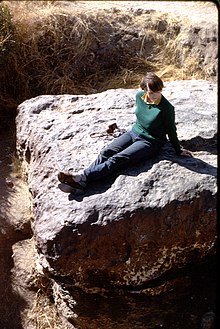Hoba meteorite
| Hoba | |
|---|---|

Relative size to humans
|
|
| Type | Iron |
| Coordinates | 19°35′32″S 17°56′01″E / 19.59222°S 17.93361°ECoordinates: 19°35′32″S 17°56′01″E / 19.59222°S 17.93361°E |
 The meteorite in 2013 after becoming a tourist attraction |
|
The Hoba (/ˈhoʊbə/ or HOH-bə) or Hoba West meteorite lies on the farm "Hoba West", not far from Grootfontein, in the Otjozondjupa Region of Namibia. It has been uncovered but, because of its large mass, has never been moved from where it fell. The main mass is estimated at more than 60 tons, making it the largest known meteorite (as a single piece) and larger than the 37-ton fragment of the Campo del Cielo. It is the most massive naturally occurring piece of iron known on Earth's surface.
The Hoba meteorite impact is thought to have occurred more recently than 80,000 years ago. It is inferred that the Earth's atmosphere slowed the object to the point that it impacted the surface at terminal velocity, thereby remaining intact and causing little excavation. Assuming a drag coefficient of about 1.3, the meteor would have been slowed to about 720 miles per hour (0.32 km/s) from its speed on entering the Earth's atmosphere, typically in excess of 10 km/s for similar objects. The meteorite is unusual in that it is flat on both major surfaces, possibly causing it to have skipped across the top of the atmosphere like a flat stone skipping on water.
The Hoba meteorite left no preserved crater and its discovery was a chance event. The owner of the land, Jacobus Hermanus Brits, encountered the object while ploughing one of his fields with an ox. During this task, he heard a loud metallic scratching sound and the plough came to an abrupt halt. The obstruction was excavated, identified as a meteorite and described by Mr. Brits, whose report was published in 1920 and can be viewed at the Grootfontein Museum in Namibia.
...
Wikipedia
